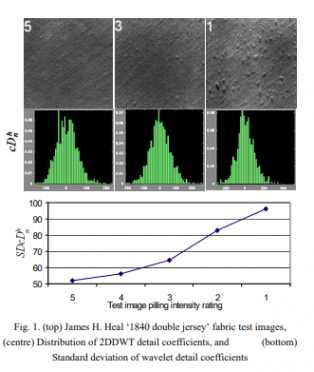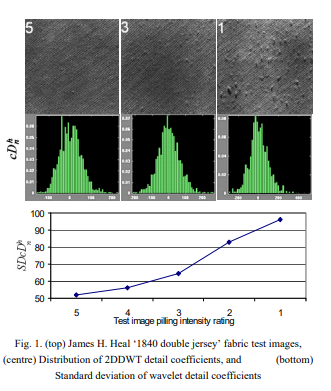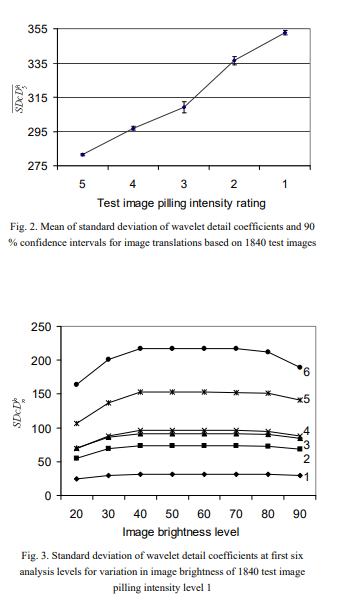Products
News
Contact
- Qinsun Instruments Co., Ltd.
- Tell:+86-21-6780 0179
- Phone:+86-17740808215
- Address:No. 2578 Minhang District Gu Dai Road, Shanghai
- Contact:Mr. Li
- QQ:846490659
The method of objective Assessment of Pilling of Nonwoven Fa

Pilling is the formation of small tangles of fibers or balls on the surface of a fabric during washing, testing or in wear. The ‘pills’ on a fabric surface make the fabric very unsightly and such fabrics are rejected by discerning consumers. Pilling has been a serious problem for the apparel industry, which has traditionally been dominated by knitted and woven fabrics. The rapid development of nonwoven apparels in recent years has added a new dimension to the perennial problem of fabric pilling, and no fundamental research has been carried out on the pilling of nonwoven fibrous materials.
Test method:
The authors have pioneered an innovative, simpler method of objective pilling rating of woven fabrics based on quantitatively relating the standard deviation of the twodimensional discrete wavelet transform (2DDWT) detail coefficients to the intensity of woven fabric pilling. Fig.
1 shows:
a) three of the five standard pilling evaluation test images from the James H. Heal & Company Limited‘1840 double jersey’ set, including the supplier rated intensity of pilling (5 = unpilled, 3 = moderately pilled, 1 =heavily pilled);
b) the distribution of the 2DDWT horizontal detail coefficients at four levels of analysis using the Haar wavelet; and c) the plot of test image pilling intensity versus the standard deviation of the distribution of the 2DDWT level four detail coefficients.

The authors have developed a heuristic method for selecting the optimal wavelet analysis parameters [PAL, 03b], and established that the method is robust to translation of the sample under test (see Fig. 2) and to variations in the illumination of the sample under test (see Fig. 3) [PAL,04]. The application of wavelet analysis to the automated detection of fabric flaws is an emerging field [HU, 00,LAT, 01, LI, 02, SAR, 99, WEN, 01], however, the prior and current work by the authors is significant as it is the first appearance in the literature of the application of wavelet analysis to the problem of objective rating of pilling intensity. The underlying technique, wavelet analysis, offers novel approaches for tackling the objective assessment of pilling using image analysis for nonwovens as well.

OBJECTIVE ASSESSMENT OF PILLING OF NONWOVEN FABRICS :
Resistance to pilling is normally tested by simulated accelerated wear, followed by a manual assessment of the degree of pilling based on a visual comparison of the sample to a set of test images. There exists one set of international standard test images based on nonwoven wool fabric, the Woolmark ‘SM50 Blanket’ set. This image set provides four representative samples for each of five levels of pilling intensity Fig. 4 shows one of the representative samples for three of the five standard pilling evaluation test images from the Woolmark ‘SM50 Blanket’ set, including the supplier rated intensity of pilling (5= unpilled, 3 = moderately pilled, 1 = heavily pilled). This test image set will be used as the basis for developing a wavelet-based image analysis technique for objectively assessing pilling intensity for nonwoven wool fabrics.
The two-dimensional discrete wavelet transform process produces two complimentary analysis components – detail coefficients and approximation coefficients. The detail coefficients represent the high spatial frequency components of the image, and are the basis used by the authors to characterize the impact of pilling on the periodic structure (fabric knit or weave) present in woven fabrics[PAL, 03a]. For nonwoven fabrics, the authors propose that the random/aperiodic structure of the fabric can be characterized by the wavelet approximation coefficients,which represent the low spatial frequency components of the image. The authors propose that there will be a wavelet analysis scale that willdistinguish between the underlying random nonwoven structure and the presence of larger pill structures on the fabric sample, and, that the distribution of wavelet approximation coefficients at that analysis scale will provide a quantitative measure of pilling intensity. This proposition will be verified experimentally.
The Woolmark ‘SM50 Blanket’ set of standard pilling images presents four examples of each of the five levels of pilling intensity. These 20 images were scanned at 600 dots per inch and cropped of edge markings. While the author’s previous work with image analysis of woven fabrics based on wavelet detail coefficients has been shown to be robust to variations in image brightness, there are many image processing applications that are sensitive to image brightness variations [GHA, 02]. In this instance,we propose to use the wavelet approximation coefficients as the basis for analysis, however, as the approximation coefficients represent low frequency information in the image, they will be sensitive to variations in image brightness [MAN, 99]. Image pixel value histogram equalization is a useful method for putting images in a consistent format prior to comparison [CAS, 96], and is reported in wavelet [MOJ, 97] and other [SRI, 01] image analysis applications as a technique for dealing with variations in image brightness. The 20 images where pixel value histogram equalized.
For each of these 20 standard images, four additional images were synthesized by cropping one edge of the standard image by approximately 15 percent. This produced 100 images in total; 20 for each pilling intensity. For each of the 100 images, the standard deviation of the distribution of the approximation coefficients ( n SDcA ) at various analysis scales, based on analysis using the Haar wavelet, was computed using the Matlab Wavelet Toolbox [THE, 04]. Using the mean value of n SDcA obtained for the 20 test images at each level of pilling intensity, it was found that 2DDWT analysis at scale five produced a monotonic relationship between pilling intensity and 5 SDcA . Fig. 5 presents the mean value and 90 percent confidence intervals for 5 SDcA (standard deviation of the distribution of wavelet approximation coefficients for level 5 analysis) for each pilling intensity.
It is proposed that it is possible to apply this image analysis method to a set of reference fabric pilling samples to develop a calibrated characteristic curve that relates pilling intensity to n SDcA obtained by analysis of a fabric test sample. In this way it is possible to perform an evaluation of pilling intensity that is analogous to the visual comparison method but, once calibrated for a given fabric type and test environment, will yield an objective measure without human interpretation.





